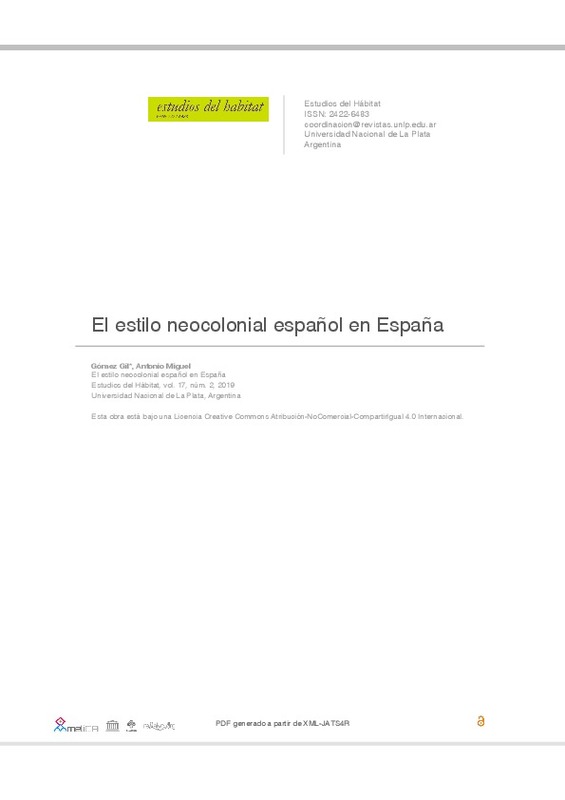JavaScript is disabled for your browser. Some features of this site may not work without it.
Buscar en RiuNet
Listar
Mi cuenta
Estadísticas
Ayuda RiuNet
Admin. UPV
El estilo neocolonial español en España
Mostrar el registro sencillo del ítem
Ficheros en el ítem
| dc.contributor.author | Gómez Gil, Antonio Miguel
|
es_ES |
| dc.date.accessioned | 2020-12-04T04:32:35Z | |
| dc.date.available | 2020-12-04T04:32:35Z | |
| dc.date.issued | 2019-12-31 | es_ES |
| dc.identifier.uri | http://hdl.handle.net/10251/156429 | |
| dc.description.abstract | [ES] El artículo aborda la cuestión del desarrollo del neocolonial español, como un estilo arquitectónico, válido para afrontar la modernidad en la primera mitad del siglo XX. Pero se presta especial atención a su aceptación y desarrollo en España, que suele ser un extremo poco estudiado. Se muestra el interés por conseguir una unidad social iberoamericana, incluso proponiendo la existencia de una ¿quinta raza¿ cultural, que como una muestra más de unidad, también compartiría ese estilo arquitectónico intercontinental. Es notable la voluntad de los arquitectos comprometidos para lograrlo, que introducían en sus proyectos, repertorios ornamentales de distintos lugares de la comunidad iberoamericana. Se llama especialmente la atención sobre la importancia del desarrollo del estilo, con unas plantas arquitectónicas modernas y procedentes de la arquitectura anglosajona, que nada tenían que ver con la tradición constructiva ibérica y que le otorgaban funcionalidad. | es_ES |
| dc.description.abstract | [EN] The article addresses the development of the Spanish Colonial Revival style, as an architectural style, valid to face modernity in the first half of the 20th century. But special attention is paid to its acceptance and development in Spain, which is often an extreme little studied. It shows the interest in achieving an Iberic-American social unit, even proposing the existence of a cultural "fifth race" that, as a further example of unity, would also share that intercontinental architectural style. It is remarkable the will of the architects committed to achieve it, who introduced into their projects, ornamental repertoires from different places of the Iberic-American community. It is especially called attention to the importance of the development of style, with modern architectural plants and from the Anglo-Saxon architecture, which had nothing to do with the Iberian building tradition and that gave it functionality. | es_ES |
| dc.language | Español | es_ES |
| dc.publisher | Universidad Nacional de La Plata | es_ES |
| dc.relation.ispartof | Estudios del Hábitat (Online) | es_ES |
| dc.rights | Reconocimiento - No comercial - Compartir igual (by-nc-sa) | es_ES |
| dc.subject | Neocolonial en España | es_ES |
| dc.subject | Arquitectura Iberoamericana | es_ES |
| dc.subject | Martín Noel | es_ES |
| dc.subject | Exposición Iberoamericana 1929 | es_ES |
| dc.subject | Raza cósmica | es_ES |
| dc.subject.classification | COMPOSICION ARQUITECTONICA | es_ES |
| dc.title | El estilo neocolonial español en España | es_ES |
| dc.title.alternative | Colonial Revival architecture style in Spain | es_ES |
| dc.type | Artículo | es_ES |
| dc.identifier.doi | 10.24215/24226483e074 | es_ES |
| dc.rights.accessRights | Abierto | es_ES |
| dc.contributor.affiliation | Universitat Politècnica de València. Departamento de Composición Arquitectónica - Departament de Composició Arquitectònica | es_ES |
| dc.description.bibliographicCitation | Gómez Gil, AM. (2019). El estilo neocolonial español en España. Estudios del Hábitat (Online). 17(2):1-27. https://doi.org/10.24215/24226483e074 | es_ES |
| dc.description.accrualMethod | S | es_ES |
| dc.relation.publisherversion | https://doi.org/10.24215/24226483e074 | es_ES |
| dc.description.upvformatpinicio | 1 | es_ES |
| dc.description.upvformatpfin | 27 | es_ES |
| dc.type.version | info:eu-repo/semantics/publishedVersion | es_ES |
| dc.description.volume | 17 | es_ES |
| dc.description.issue | 2 | es_ES |
| dc.identifier.eissn | 2422-6483 | es_ES |
| dc.relation.pasarela | S\401224 | es_ES |








